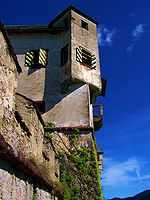Hochosterwitz Castle

Hochosterwitz Castle (German: Burg Hochosterwitz) is considered to be one of Austria's most impressive medieval castles. It is situated on a 160 metres (520 ft) Dolomite rock near Sankt Georgen am Längsee, east of the town of Sankt Veit an der Glan in the state of Carinthia. The castle is one of the state's landmarks and can be seen from about 30 km (19 mi) away on a clear day.
History
The site was first mentioned in a 860 deed issued by King Louis the German of East Francia, donating several of his properties in the former Principality of Carantania to the Archdiocese of Salzburg. It was then named as ‘Astarwiza’,[2] its name being of Slavic origin. In the 11th century Archbishop Gebhard of Salzburg ceded the castle to the Dukes of Carinthia from the noble House of Sponheim in return for their support during the Investiture Controversy. The Sponheim dukes bestowed the fiefdom upon the family of Osterwitz, who held the hereditary office of the cup-bearer in 1209.[2]

In his book Change the Austro-American psychologist Paul Watzlawick renders a popular tale of the siege of the castle by the troops of Margarete Maultasch ("Mouth Bag"), Countess of Tyrol from 1335 to 1363. According to legend first noted by the medieval chronicler Jakob Unrest and later by Jacob Grimm, Margarete, cheated by the House of Habsburg of her inheritance claims to Carinthia, invaded the duchy; her forces were however deceived and withdrew when the garrison of Hochosterwitz slaughtered its very last ox, filled it with corn and threw it over the wall, pretending it still had so many provisions in stock that they could be used as projectiles.
In the 15th century, the last Carinthian cup-bearer, Georg of Osterwitz was captured in a Turkish invasion and died in 1476 in prison without leaving descendants.[3] Hans, cup-bearer of Osterwitz was the last remaining survivor of the family. He had a substantial debt owing to the Emperor and was forced to give up the deeds of the castle to pay his debt.[3] So after four centuries, on 30 May 1478, the possession of the castle reverted to Emperor Frederick III of Habsburg.[3]
Over the next thirty years the castle was badly damaged by numerous Turkish campaigns. On 5 October 1509, Emperor Maximilian I handed the castle as a pledge to Matthäus Lang von Wellenburg, then Bishop of Gurk.[4] Bishop Lang undertook a substantial renovation project for the damaged castle.

About 1541 German king Ferdinand I of Habsburg bestowed Hochosterwitz upon the Carinthian governor Christof Khevenhüller. In 1571, Baron George Khevenhüller acquired the citadel by purchase. He fortified to deal with the threat of Turkish invasions of the region, building an armoury and 14 gates from 1570-1586. Such massive fortification is considered unique in citadel construction. Because of the 14 gates, each equipped with different treacherous methods of guarding the path, local legend maintains that the castle has never been conquered and that none of the attacks managed to get beyond the fourth (Engelstor) gate.
Present
Since the 16th century, no major changes have been made to Hochosterwitz. It has also remained in the possession of the Khevenhüller family as requested by the original builder, George Khevenhüller. A marble plaque dating from 1576 in the castle yard documents this request.
Some parts of the castle are open to the public every year from Easter to the end of October. Tourists are allowed to walk the 620 metres (2,030 ft) long pathway through the 14 gates up to the castle; each gate has a diagram of the defense mechanism used to seal that particular gate.
Hochosterwitz Castle can be reached by car or an easy hike from Launsdorf-Hochosterwitz train station, with connection to nearby Klagenfurt.
A 1:25 miniature scale model of Hochosterwitz Castle may be seen at Minimundus, a popular tourist attraction in Klagenfurt approximately 20 km (12 mi) away.
Gallery
-

Looking Northwest from the top of the castle
-

Battlements at the beginning of the path.
-

Hochosterwitz in winter
-
Castle garden, with church spire in background
References
- Moro, Gobert (1966). "The Province of Carinthia, historical survey". Handbook of the historical places of Austria. Stuttgart.
- Kohla, Franz X; Gobert Moro (1976). Carinthian castle information (in German). Klagenfurt.
- Khevenhüller-Metsch, Georg (2001). Max Khevenhüller-Metsch, ed. Castle Hochosterwitz. Klagenfurt: Carinthian Bogendruck.
External links
| Wikimedia Commons has media related to Burg Hochosterwitz. |
- Burg Hochosterwitz Official Site (retrieved Nov 6, 2005)
- Burg Hochosterwitz Burg Galerie Official Site (retrieved Jul 3, 2010)
Notes
Coordinates: 46°45′18″N 14°27′13″E / 46.75500°N 14.45361°E
